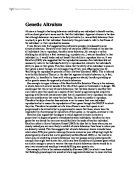Genetic Altruism Altruism is thought of as being behaviour exhibited by one individual to benefit another, with no direct gain but at some cost for that first individual. Apparent altruism is the idea that although behaviour may seem to be fully altruistic (i.e. non-selfish) behaviour there is actually a gain for that individual. Genetically this gain tends to refer to the fitness of the individual i.e. their reproductive success. It was Darwin who first suggested the problematic paradox introduced by some altruistic behaviour. Darwin's initial theory of evolution (1859) is based on the idea that all individuals live to reproduce, therefore some behaviour, for example a mother shielding her child from a fatal instance (e.g. a predator etc...) was not beneficial to that individual i.e. it would hinder and not benefit their ability to reproduce later on. It was Hamilton (1963) who suggested that the reproductive success of an individual did not necessarily relate to the individual's ability to reproduce but related to the individual's ability to pass on their genes. This then means that the ability of an individual to pass on their genes is done through, not only supporting of their own offspring but also by 'facilitating the reproductive potential of their relatives' (Cardwell 1996). This is referred to as the Kin Selection Theory i.e. the idea that apparent







